K. M. Vasudevan Namboothiri surpasses definitions. As he turns 90, it is time to trace the trajectory of Artist Namboothiri, as he is affectionately known, who defied conventional wisdom to etch an iconic aura to his varied sketches.
“It isn’t my Bhima that people saw in Randamoozham, but his”, as M. T. Vasudevan Nair would vouch. VKN referred to him as the ‘Paramashivan of line sketches’. Namboothiri stormed into the art scene when readers and illustrators couldn’t think beyond a colonial Ravi Varma and his artistry. Namboothiri’s illustrations, especially his line drawings, were a recalling of the robust heritage of Kerala.
With his firm strokes, he brought back on canvas what was missing in the art fraternity of the time—a reclaiming of historical Kerala. The maestro of lines whose sketches transcended the mindscapes of his illustrious characters through his seemingly abstract yet absorbingly detailed lines, sketches the lingering portrait of his own life and times to Onmanorama.
Looking back, at 90
When Artist Namboothiri starts to talk, what strikes one at once as odd and immeasurably surprising is how humble he is. Marred by nothing, including his achievements, he says, “When I look back, it all feels like a miracle. Nothing of what I have was aspired for, not even dreamed”, says the man who created new pathways in the visual landscape of Kerala.
Early days in Madras with KCS Panicker
“In my younger days, KCS was a revered figure for me; to have come under his tutelage amounts to quite an experience”. It’s especially fascinating to note that Namboothiri completed the 6-year painting course under Panicker in just one year!
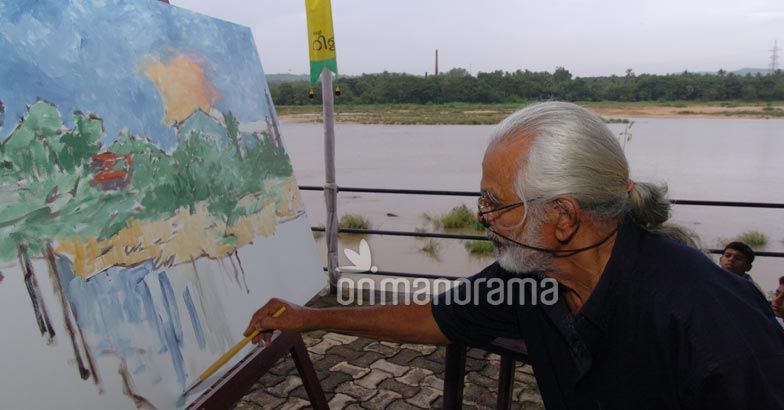 KCS Panicker was one among the forces that moulded the perception of Namboothiri. File photo
KCS Panicker was one among the forces that moulded the perception of Namboothiri. File photoHe also mentions the inspiration that was Debi Prasad Roy Chowdhury, the then Principal of Madras school of fine arts. A renowned painter and sculptor, he was one among the forces that moulded the perception of Namboothiri.
“To have studied from them, rather, to have lived with them for a while was a blessing in itself. They are the change that made me; without them, I wouldn’t have become an artist, I would’ve been a temple priest or maybe even a caterer (traditional occupations sought by the Namboothiri community in those times)”
Life of an artist
N. V. Krishna Varrier, the chief editor of Mathrubhumi weekly and M. T. Vasudevan Nair had heard of Artist Namboothiri from artist M. V. Devan, and they invited him over to Mathrubhumi to join them. “I was happy to note that there was a juncture in my life where I got called in to be an illustrator in Mathrubhumi. During those times, events like these seldom happened”.
“Working with M. V. Devan and hordes of writers of calibre during the time, further chiselled my outlook”, something that he says he was fortunate to be a part of.
Lines and art
M. T. Vasudevan has said in Randamoozham that what he found fascinating was the gaps left in mythological narratives. He saw these gaps as areas where imagination sprouted visions for further narration. Namboothiri’s art is something akin to this identification—there are feelings of incompleteness at first glance, but on closer examination, they are deep in their portrayal.
“Line drawings were my forte; lines can bring about a three dimensional character to structures on flat surface unlike other drawings. I see things in a three dimensional format, and mostly that’s the kind of illustration that appeals to me. Any style that has come along with it, is merely coincidental”
Versatility being second nature to him, Artist Namboothiri finds sculpting, painting and illustrating, all congenial to him. “The challenge of bringing out the two or three dimensional facets of a drawing is something I enjoy, and it’s always a joy to be creating something new”, he says.
 Copper-relief painting done by Artist Namboothiri.
Copper-relief painting done by Artist Namboothiri.On his depictions and Randamoozham
“While sketching many a character, I’ve often felt that they must be people I’ve met and known. We meet so many people every day who influence us. So this was a natural progression. Although, while re-imagining characters in Randamoozham, I had to think through them. Even though M. T. Vasudevan Nair’s attempt was to humanise his protagonists, they had to look more than human”.
He drew inspiration from the Chola and Pallava sculptures, and those from Mahabalipuram, Ajanta and Ellora. Keeping temple structures in view, he modified his view and recreated Bhima and others in Randamoozham that brought him unprecedented fame, which he translates simply as “people seemed to have liked them”, according credits to the novel.
Namboothiri’s beautiful women
Namboothiri’s drawings produce an inimitable beauty in his women characters. And it’s been an enduring question to the maestro. His men are tall and well built, while the women are seductively beautiful.
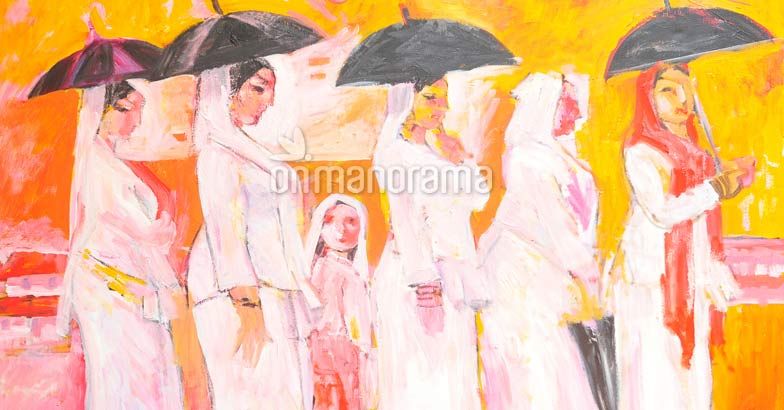 Namboothiri’s drawings produce an inimitable beauty in his women characters
Namboothiri’s drawings produce an inimitable beauty in his women characters“I do incline towards drawing tall and well-built men, although going by the proportion, they aren’t huge. And one doesn’t have much to compromise on, when the only concern is the ink,” he says. “And as for the women, they are all supposed to be beautiful, aren’t they?”
Quite in line with that, he recounts a popular joke that V. M. Nair of Mathrubhumi made—“he once told me, writers might sometimes portray the women in their works as sad or even ugly, but you don't bother about that; make sure that you draw them out to be beautiful looking!” At the end of the day, the magazine had to sell.
On 'Nagarangal'
On the project of 'Nagarangal' where he was to bring cities to his canvas, Artist Namboothiri started with Kochi. “This project has the potential to carry on, whether in the form of cities or people; to focus on one particular aspect and making sketches on it is an idea that I would like to see materailised.”
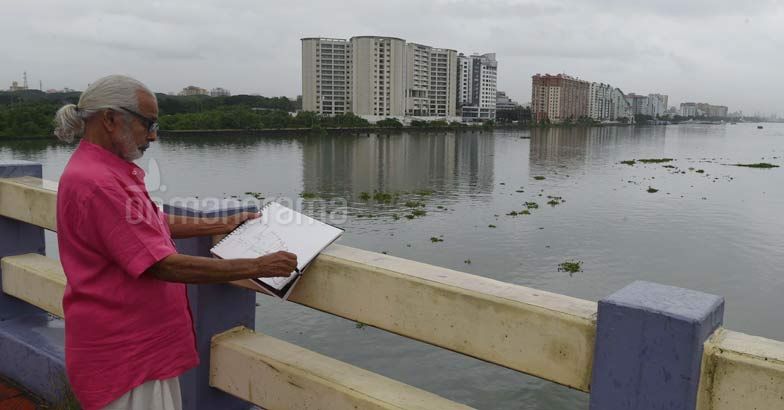 Artist Namboothiri sketching Kochi on his canvas. Photo: Robert Vinod
Artist Namboothiri sketching Kochi on his canvas. Photo: Robert VinodArtist's liberty
It is a striking factor that must have occurred to some—an illustrator is the first person to imagine the writer's character and visualise a form. It is that form that gets presented in front of the readers. How does he feel to wield this authority over people's imagination?
“It sure is overwhelming. And it comes with its limitations. The characters come alive in each person's mind differently, but yes, to have to visualise it first is a task that has to be done judiciously. But then again, there is no last word regarding these things”.
“There are times when I've felt that the illustrations could have been better. I had a similar concern with VKN's Sir Chathu. When I told him I would have preferred to draw them differently now, he said, he would then rewrite the story for me!” “And there have been times when some of the drawings when seen after a considerable amount of time have left me surprised. I would go on to think I cannot reproduce them anymore”.
“In the life of every artist, be it a musician, actor or illustrator, there are times when the art or craft shoots up far beyond one's own reach. It's a spectacle that has happened to many. And I'm sure it will keep on happening. There will be transformations in art and cultures, but the inherent humaneness would remain intact”, he said.
The bond with VKN
It's a known fact that VKN adored Namboothiri. VKN had once even said that his story was a post script to Namboothiri's illustrations. The affection is reciprocated by Namboothiri as well.
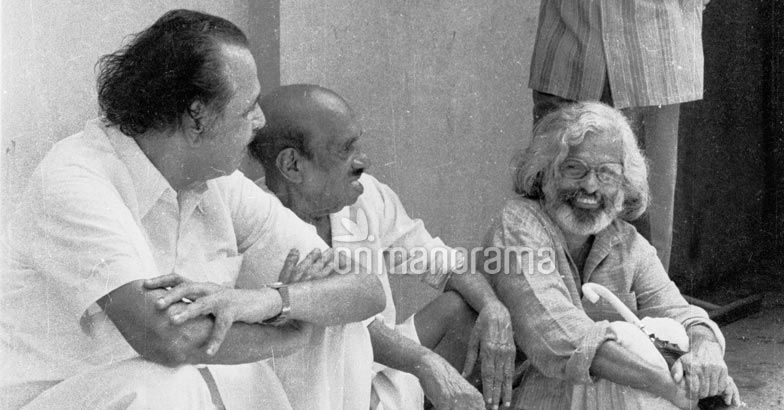 From Left: VKN, Basheer and Namboothiri
From Left: VKN, Basheer and Namboothiri“VKN and I shared a special bond. I used to visit him at his home. We used to correspond through letters as well”. There is a well known incident of correspondence between Namboothiri and VKN that was the talk among many circles once. Namboothiri elaborated on it thus—when VKN came to know that my illustration of one of his women characters was becoming the talk of the town, he wrote to me saying, “If she is indeed so beautiful, you should be sending her to me instead of letting her stay with you!”
On writing and 'Rekhakal'
Artist Namboothiri's writings are as meticulous and deep as his paintings. He had started writing anecdotes in Bhashaposhini that talked of people, places and experiences he had encountered starting from his childhood. “There were so many memories, I had to jot them down. There are still more, I hope to write more”.
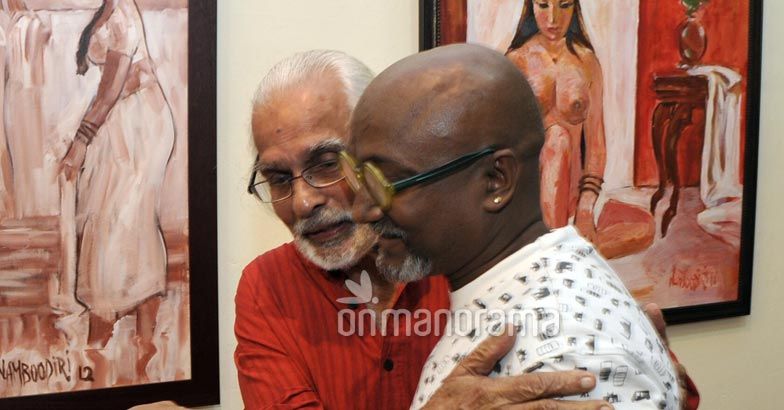 Namboothiri with Bose Krishnamachari at Kochi Muziris Biennale
Namboothiri with Bose Krishnamachari at Kochi Muziris BiennaleOn Biennale
“Being part of the second Biennale and having been to both that were organised in Kochi, I thought it was a good endeavour, especially the second one. There were a lot of people who were against the Biennale. I saw no reason to be against it. A sort of looking back at one's own culture or history is always good,” he said.
A lot can happen over tea
 Artist Namboothiri with Mohanlal, when the actor visited him at his home in Edappal.
Artist Namboothiri with Mohanlal, when the actor visited him at his home in Edappal. “It all happened over tea”, he said. There was a clique of writers and directors in Kozhikode at the time, who used to meet up and discuss ideas. Among them were Thikkodiyan, Aravindan and many others. The idea of 'Utharayanam' was born then. Although Aravindan was initially hesitant, he did the movie 'Utharayanam' finally, and I was just part of it because I happened to be there at that time. I don't have a strong inclination towards movies,” he said. “Similar was the case with Padmarajan too. Apart from designing the Gandharvan's (Njan Gandharvan) headgear, I cannot claim much.”
The foremost art form
Despite garnering much applause for his works, Artist Namboothiri feels that, to him, music is the foremost art form. “No other medium of art is capable of melting the human minds thus”, he says. “Music wasn't something I could do, so I took up what I knew,” says the man who in M T Vasudevan Nair's words is an “artist who can stump international works, had there been more prominence given to art in those times”.

















































 at a workshop by artist John Baby (left) at the art room of the Kochi-Muziris Biennale in December.jpg.image.160.84.jpg)






















.jpg.image.160.84.jpg)

.jpg.image.160.84.jpg)












































































































































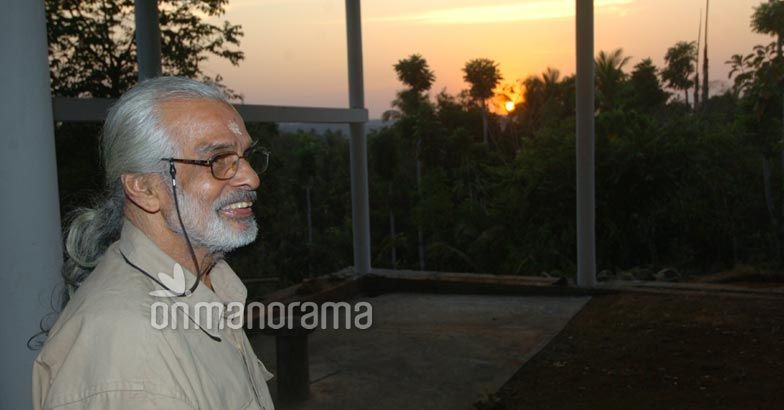 K. M. Vasudevan Namboothiri
K. M. Vasudevan Namboothiri
Disclaimer
The comments posted here/below/in the given space are not on behalf of Manorama. The person posting the comment will be in sole ownership of its responsibility. According to the central government's IT rules, obscene or offensive statement made against a person, religion, community or nation is a punishable offense, and legal action would be taken against people who indulge in such activities.